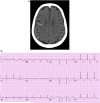Ischemic-appearing electrocardiographic changes predict myocardial injury in patients with intracerebral hemorrhage
- PMID: 21450435
- PMCID: PMC3684165
- DOI: 10.1016/j.ajem.2011.02.007
Ischemic-appearing electrocardiographic changes predict myocardial injury in patients with intracerebral hemorrhage
Abstract
Objectives: Myocardial injury is common among patients with intracerebral hemorrhage (ICH). However, it is challenging for emergency physicians to recognize acute myocardial injury in this population, as electrocardiographic (ECG) abnormalities are common in this setting. Our objective is to examine whether ischemic-appearing ECG changes predict subsequent myocardial injury in the context of ICH.
Methods: Consecutive patients with primary ICH presenting to a single academic center were prospectively enrolled. Electrocardiograms were retrospectively reviewed by 3 independent readers. Anatomical areas of ischemia were defined as I and aVL; II, III, and aVF; V(1) to V(4); and V(5) and V(6). Medical record review identified myocardial injury, defined as troponin I or T elevation (cutoff 1.5 and 0.1 ng/mL, respectively), within 30 days.
Results: Between 1998 and 2004, 218 patients presented directly to our emergency department and did not have a do-not-resuscitate/do-not-intubate order; arrival ECGs and troponin levels were available for 206 patients. Ischemic-appearing changes were noted in 41% of patients, and myocardial injury was noted in 12% of patients. Ischemic-appearing changes were more common in patients with subsequent injury (64% vs 37%; P = .02). After multivariable analysis controlling for age and cardiac risk factors, ischemic-appearing ECG changes independently predicted myocardial injury (odds ratio, 3.2; 95% confidence interval, 1.3-8.2). In an exploratory analysis, ischemic-appearing ECG changes in leads I and aVL as well as V(5) and V(6) were more specific for myocardial injury (P = .002 and P = .03, respectively).
Conclusion: In conclusion, although a range of ECG abnormalities can occur after ICH, the finding of ischemic-appearing changes in an anatomical distribution can help predict which patients are having true myocardial injury.
Copyright © 2012 Elsevier Inc. All rights reserved.
Figures

References
-
- Dixon AA, Holness RO, Howes WJ, et al. Spontaneous intracerebral haemorrhage: an analysis of factors affecting prognosis. Can J Neurol Sci. 1985;12(3):267–71. - PubMed
-
- Qureshi AI, Tuhrim S, Broderick JP, et al. Spontaneous intracerebral hemorrhage. N Engl J Med. 2001;344(19):1450–60. - PubMed
-
- Tuhrim S, Dambrosia JM, Price TR, et al. Prediction of intracerebral hemorrhage survival. Ann Neurol. 1988;24(2):258–63. - PubMed
-
- Broderick J, Connolly S, Feldmann E, et al. Guidelines for the management of spontaneous intracerebral hemorrhage in adults: 2007 update: a guideline from the American Heart Association/American Stroke Association Stroke Council, High Blood Pressure Research Council, and the Quality of Care and Outcomes in Research Interdisciplinary Working Group. Stroke. 2007;38(6):2001–23. - PubMed
Publication types
MeSH terms
Substances
Grants and funding
LinkOut - more resources
Full Text Sources

